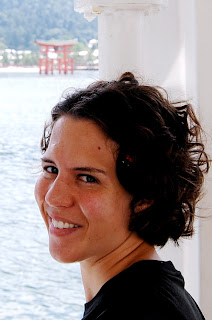It turned out to be a blessing in disguise.
Knowing that I would be hopelessly late to class, I gave up the search and began poking along back to the train station. That's when I came across an old building marked as the Former Bank of Japan, Hiroshima Branch. The old bank was one of the few structures to survive the blast of the atomic bomb in 1945, and it was the most well preserved.
A sign said an exhibit of paper cranes was on display inside, free to the public. So I wandered in. Inside, the thick stone walls blocked out the sound of the city, a still silence hanging in the air.
I walked through the barren first floor, keenly aware of the sound of my footsteps slicing through the silence, and followed the signs up the stairs to the third floor, where I was greeted by a bored security guard. I had the place to myself.
Stepping through a door into one room of the exhibit, I drew in my breath. Stunned, I stood back to admire the giant mounds of paper cranes, in all colors of the rainbow, heaped before me nearly as high as the ceiling.

Ten million paper cranes, a symbol of peace, formed a small mountain range on the third floor of the bank. In a neighboring room, garlands made of colorful cranes blanketed every wall. And these were the cranes sent to Hiroshima just in 2002. Every year, 10 million cranes are delivered to the city for display at the Children's Peace Monument in Peace Park.

The monument memorializes Sadako Sasaki, who was 2 years old when she was exposed to the atomic bomb that fell on Hiroshima. She survived with no external wounds and grew into a strong and athletic girl. Nine years later, in sixth grade, she was suddenly diagnosed with leukemia and hospitalized.

While in the hospital, Sadako clung tightly to her belief in an ancient Japanese legend that states that a person who folds a thousand cranes would be granted a wish. For eight months, she continuously folded tiny paper cranes out of medicine wrappers and other paper in hopes that she would be cured.

She never gave up her hope for recovery, folding more than 1,000 cranes before passing away at age 12 in 1955.
As Sadako's story became widely known, the folded origami paper crane gradually became symbolic of the call for peace. Her bronze statue in Peace Park shows her holding a golden crane. Sometimes the monument is called the Tower of a Thousand Cranes because of the cranes offered there throughout the year.

It's a truly touching and awe inspiring sight to see that millions of people have made this gesture of peace. There are just so many, it's hard to wrap your head around the idea of it all.



If you're interested in making your own paper cranes, I found this nifty how-to video on the web. Also, the website for the city of Hiroshima tells you where to mail cranes if you want to contribute.
For any of you back home with Springfield City Schools, this could be a cool project for the high school kids once the school district has its Japanese coursework off the ground. You could send the cranes to the mayor's office or to me, and I'd be happy to deliver them. I know I plan to make some paper cranes this year and deliver them personally.
